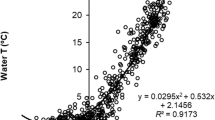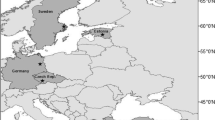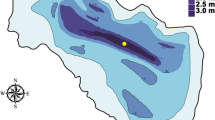Abstract
Zooplankton support a variety of important ecosystem processes in lakes but our understanding of how these organisms respond to ongoing climate change is superficial. Aquatic ecosystems have been exposed to substantial climate warming in the last century, and this trend is certain to continue, especially in northern latitudes. We analyzed a long time series of a variety of physical attributes of Lake Aleknagik, southwest Alaska, to quantify warming trends between 1963 and 2009, and to assess zooplankton community responses to variation in thermal conditions. Our analyses demonstrate clear trends toward earlier spring ice break-up, increases in average epilimnetic temperatures and an 18.5% increase in summer epilimnetic degree days since 1963. We estimated the magnitude and direction of changes in zooplankton production and end of season densities in response to changes in thermal environment, then explored whether the climate-driven responses in production are common in five large lakes that are distributed across a coastal-interior landscape gradient. Although we detected no clear directional changes in zooplankton densities or production rates, there were clear correlations between these variables and interannual variation in thermal conditions. The positive effects of earlier spring ice break-up and increase in summer degree days were strongest on the production and density responses of Daphnia and Bosmina, and the lagged effect of temperature was important and negative only for calanoid copepods. There was a negative effect of sockeye escapement to Lake Aleknagik in the previous year on all taxa. There were lake-specific effects of changes in the thermal environment on almost all taxa and small gradients in the magnitude of responses across the landscape, but no systematic patterns of landscape control.









Similar content being viewed by others
References
Adrian R, Wilhelm S, Gerten D. 2006. Life-history traits of lake plankton species may govern their phenological response to climate warming. Glob Change Biol 12:652–61.
Benson BJ, Lenters JD, Magnusson JJ, Stubbs M, Kratz TK, Dillon PJ. 2000. Regional coherence of climatic and lake thermal variables of four lake districts in the Upper Great Lakes Region of North America. Freshw Biol 43:517–27.
Bottrell HH, Duncan A, Gliwicz ZM, Grygierek E, Herzig A, Hillbrichtilkowska A. 1976. Review of some problems in zooplankton production studies. Nor J Zool 24:419–56.
Brett MT, Martin L, Kawecki TJ. 1992. An experimental test of the egg-ratio method—estimated versus observed death rates. Freshw Biol 28:237–48.
Brooks JL, Dodson SI. 1965. Predation, body size, and composition of plankton. Science 150:28–35.
Burnham KP, Anderson DR. 2004. Multimodel inference—understanding AIC and BIC in model selection. Sociol Methods Res 33:261–304.
Carpenter SR, Fisher SG, Grimm NB, Kitchell JF. 1992. Global change and fresh-water ecosystems. Annu Rev Ecol Syst 23:119–39.
Chen CY, Folt CL. 2002. Ecophysiological responses to warming events by two sympatric zooplankton species. J Plankton Res 24:579–89.
Edmondson WT. 1965. Reproduction rate of planktonic rotifers as related to food and temperature in nature. Ecol Monogr 35:61–111.
George DG, Talling JF, Rigg E. 2000. Factors influencing the temporal coherence of five lakes in the English Lake District. Freshw Biol 43:449–61.
Gerten D, Adrian R. 2000. Climate-driven changes in spring plankton dynamics and the sensitivity of shallow polymictic lakes to the North Atlantic oscillation. Limnol Oceanogr 45:1058–66.
Gerten D, Adrian R. 2002. Species-specific changes in the phenology and peak abundance of freshwater copepods in response to warm summers. Freshw Biol 47:2163–73.
Gillooly JF. 2000. Effect of body size and temperature on generation time in zooplankton. J Plankton Res 22:241–51.
Gillooly JF, Brown JH, West GB, Savage VM, Charnov EL. 2001. Effects of size and temperature on metabolic rate. Science 293:2248–51.
Hampton SE, Izmest’eva LB, Moore MV, Katz SL, Dennis B, Silow EA. 2008. Sixty years of environmental change in the world’s largest freshwater lake—Lake Baikal, Siberia. Glob Change Biol 14:1947–58.
Hanson PC, Johnson TB, Kitchell J, Schindler DE. 1997. Fish bioenergetics 3.0. University of Wisconsin Sea Grant Institute, Madison, Wisconsin, USA.
Hartmann B, Wendler G. 2005. The significance of the 1976 Pacific climate shift in the climatology of Alaska. J Clim 18:4824–39.
Havens KE, Beaver JR. 2011. Composition, size, and biomass of zooplankton in large productive Florida lakes. Hydrobiologia 668:49–60.
Havens KE, Elia AC, Taticchi MI, Fulton RS. 2009. Zooplankton–phytoplankton relationships in shallow subtropical versus temperate lakes Apopka (Florida, USA) and Trasimeno (Umbria, Italy). Hydrobiologia 628:165–75.
Hill DK, Magnuson JJ. 1990. Potential effects of global climate warming on the growth and prey consumption of Great-Lakes fish. Trans Am Fish Soc 119:265–75.
Huntley ME, Lopez MDG. 1992. Temperature-dependent production of marine copepod: a global synthesis. Am Nat 140:201–42.
IPCC. 2007. Summary for policy makers. In: Pachauri RK, Reisinger A, Eds. Climate Change 2007: Synthesis Report: Contribution of working groups I, II, and III to the fourth assessment report of the Intergovernmental Panel on Climate Change. Cambridge: Cambridge University Press. p 1–52.
Jensen OP, Benson BJ, Magnusson JJ, Card VM, Futter MN, Soranno PA. 2007. Spatial analysis of ice phenology trends across the Laurentian Great Lakes region during a recent warming period. Limnol Oceanogr 52:2013–26.
Jeppesen E, Meerhoff M, Holmgren K, Gonzalez-Bergonzoni I, Tiexiera-de Mello F, Declerck SAJ. 2010. Impacts of climate warming on lake fish community structure and potential effects on ecosystem function. Hydrobiologia 646:73–90.
Koenings JP, Edmundson JA, Kyle GB, Edmundson JM. 1987. Limnology field and laboratory manual: Methods for assessing aquatic production. Alaska Department of Fish and Game, Division of Fisheries Rehabilitation, Enhancement, and Development. Number 71.
Livingstone DM, Padisak J. 2007. Large-scale coherence in the response of lake surface-water temperatures to synoptic-scale climate forcing during summer. Limnol Oceanogr 52:896–902.
Magnuson JJ, Benson BJ, Kratz TK. 2004. Patterns of coherent dynamics within and between lake districts at local to intercontinental scales. Boreal Environ Res 9:359–69.
McDonald ME, Hershey AE, Miller MC. 1996. Global warming impacts on lake trout in arctic lakes. Limnol Oceanogr 41:1102–8.
Paloheimo JE. 1974. Calculation of instantaneous birth-rate. Limnol Oceanogr 19:692–4.
Pinheiro JC, Bates DM. 2000. Mixed effects models in S and S-Plus. New York: Springer.
Plante C, Downing JA. 1989. Production of fresh-water invertebrate populations in lakes. Can J Fish Aquat Sci 46:1489–98.
Richardson AJ. 2008. In hot water: zooplankton and climate change. ICES J Mar Sci 65:279–95.
Schindler DE, Rogers DE, Scheuerell MD, Abrey CA. 2005. Effects of changing climate on zooplankton and juvenile sockeye salmon growth in southwestern Alaska. Ecology 86:198–209.
Shuter BJ, Ing KK. 1997. Factors affecting the production of zooplankton in lakes. Can J Fish Aquat Sci 54:359–77.
Soranno PA, Webster KE, Riera JT, Kratz TK, Baron JS, Bukaveckas PA. 1999. Spatial variation among lakes within landscapes: ecological organization along lake chains. Ecosystems 2:395–410.
Stich HB, Brinker A. 2010. Oligotrophication outweighs effects of global warming in a large, deep, stratified lake ecosystem. Glob Change Biol 16:877–888.
Stockwell JD, Johannsson OE. 1997. Temperature-dependent allometric models to estimate zooplankton production in temperate freshwater lakes. Can J Fish Aquat Sci 54:2350–60.
Straile D, Geller W. 1998. The response of Daphnia to changes in trophic status and weather patterns: a case study from Lake Constance. ICES J Mar Sci 55:775–82.
Straile D. 2000. Meteorological forcing of plankton dynamics in a large and deep continental European lake. Oecologia 122:44–50.
Straile D, Adrian R. 2000. The North Atlantic Oscillation and plankton dynamics in two European lakes - two variations on a general theme. Glob Change Biol 6:663–70.
Vogt PJ, Rusak JA, Patoine A, Leavitt PR. 2011. Differential effects of energy and mass influx on the landscape synchrony of lake ecosystems. Ecology 92:1104–14.
Wagner C, Adrian R. 2009. Exploring lake ecosystems: hierarchy responses to long-term change? Glob Change Biol 15:1104–15.
Winder M, Schindler DE. 2004a. Climatic effects on the phenology of lake processes. Glob Change Biol 10:1844–56.
Winder M, Schindler DE. 2004b. Climate change uncouples trophic interactions in an aquatic system. Ecology 85:3178.
Winder M, Schindler DE, Essington TE, Litt AH. 2009. Disrupted seasonal clockwork in the population dynamics of a freshwater copepod by climate warming. Limnol Oceanogr 54:2493–505.
Zuur AF, Ieno EN, Walker N, Saveliev AA, Smith GM. 2009. Mixed effects models and extensions in ecology with R. New York: Springer.
Acknowledgments
The authors thank the Gordon and Betty Moore foundation and the National Science Foundation for their support. Many people had a hand in collecting these data over the last 46 years, but we would like to especially acknowledge Don Rogers, Brenda Rogers, Tom Rogers, Chris Boatright, Harry Rich Jr., and Brandon Chasco, as well as the numerous field technicians and students involved in the research program. Lauren Rogers, Tim Essington, Brandon Chasco and Bridget Ferris provided invaluable help with mixed-effect models and Shannon O’Brien assisted with the creation of the figures. Mike Brett, Karl Havens, Eric Jeppesen, and one anonymous reviewer improved earlier versions of the manuscript. This is a contribution of the Alaska Salmon Program, of the University of Washington, School of Aquatic and Fishery Sciences.
Author information
Authors and Affiliations
Corresponding author
Additional information
Author Contributions
JLC conceived of or designed research, performed research, analyzed data, wrote paper. DES conceived of or designed research, performed research, wrote paper.
Electronic supplementary material
Below is the link to the electronic supplementary material.
Rights and permissions
About this article
Cite this article
Carter, J.L., Schindler, D.E. Responses of Zooplankton Populations to Four Decades of Climate Warming in Lakes of Southwestern Alaska. Ecosystems 15, 1010–1026 (2012). https://doi.org/10.1007/s10021-012-9560-0
Received:
Accepted:
Published:
Issue Date:
DOI: https://doi.org/10.1007/s10021-012-9560-0




